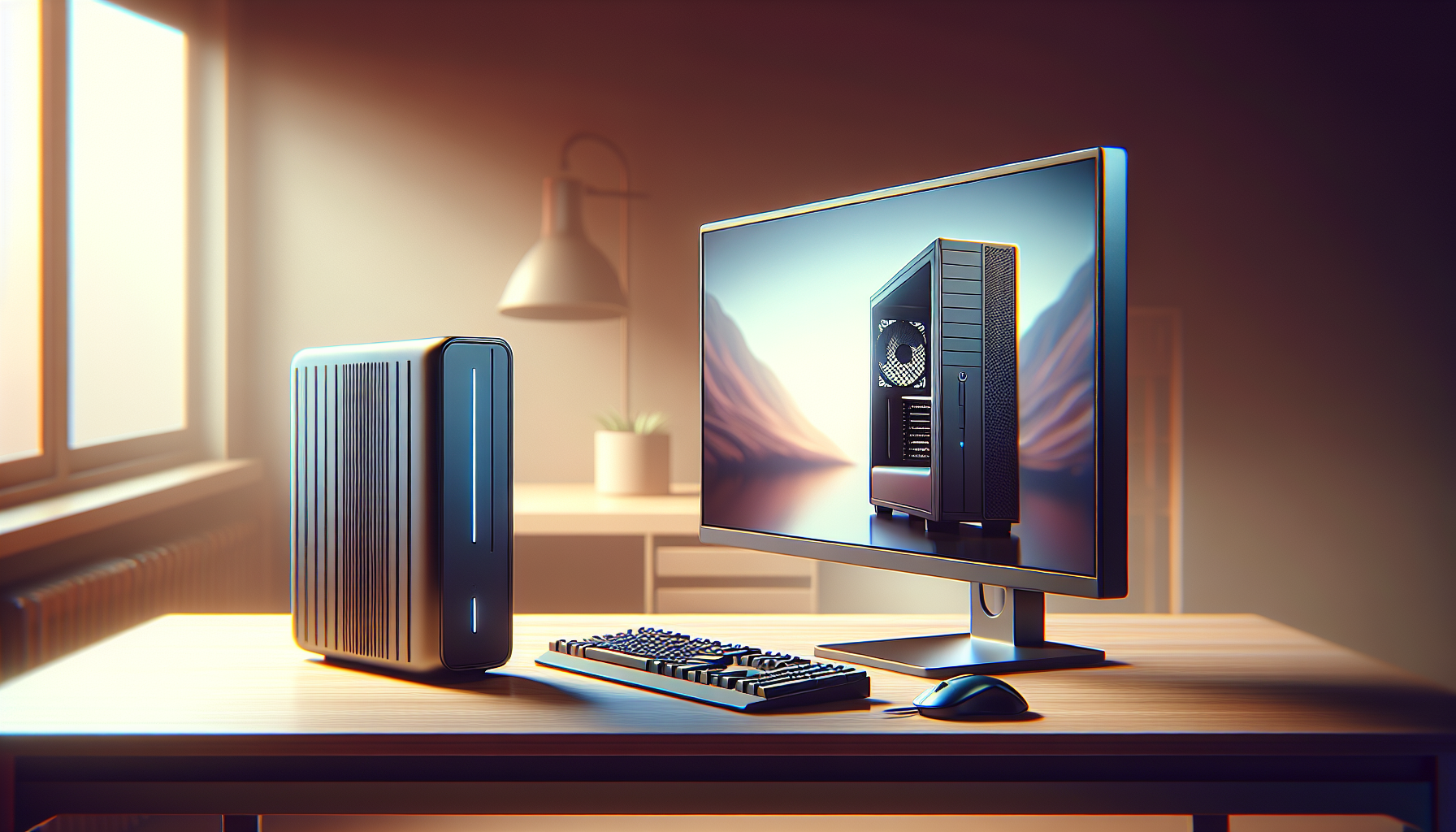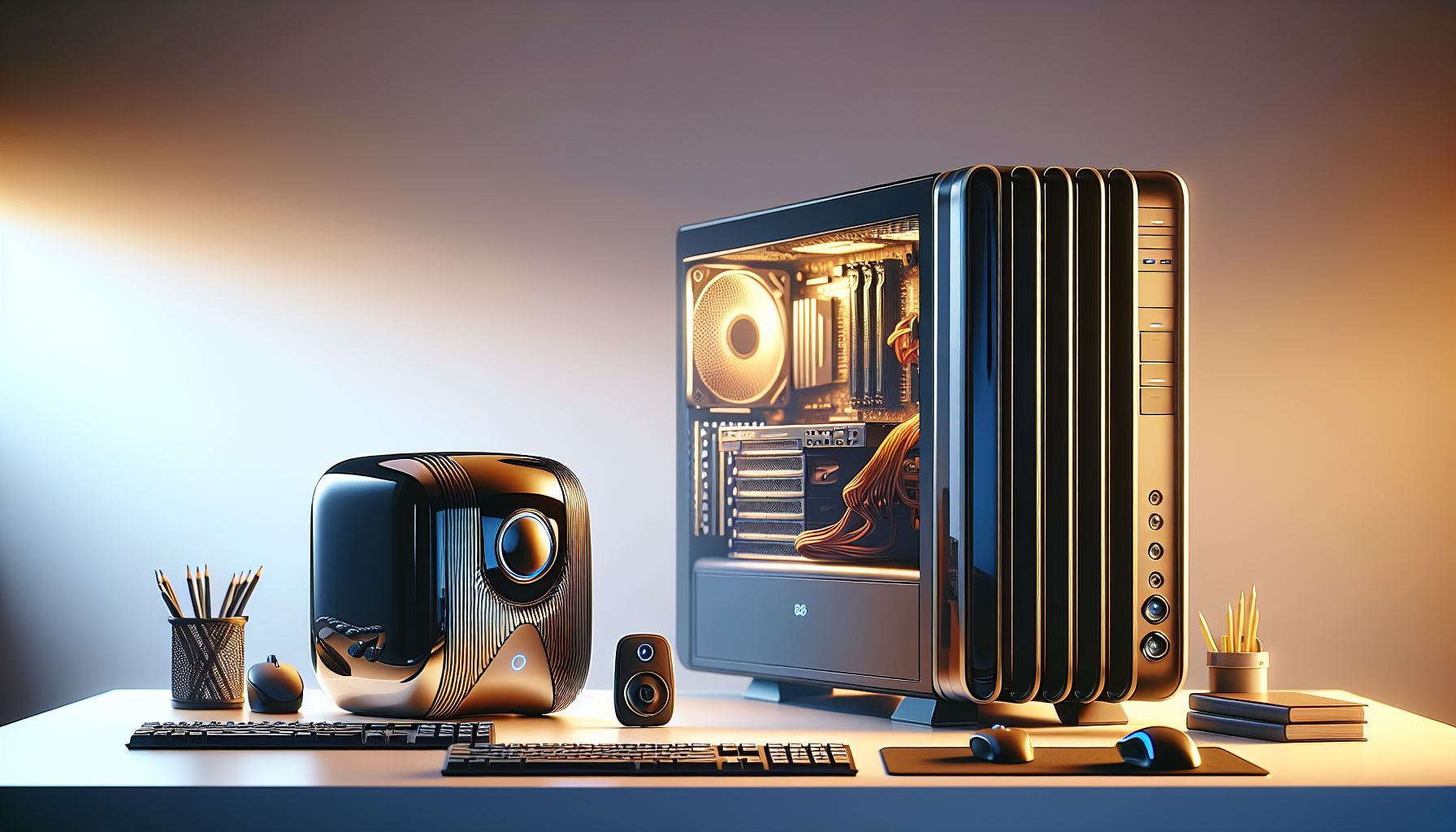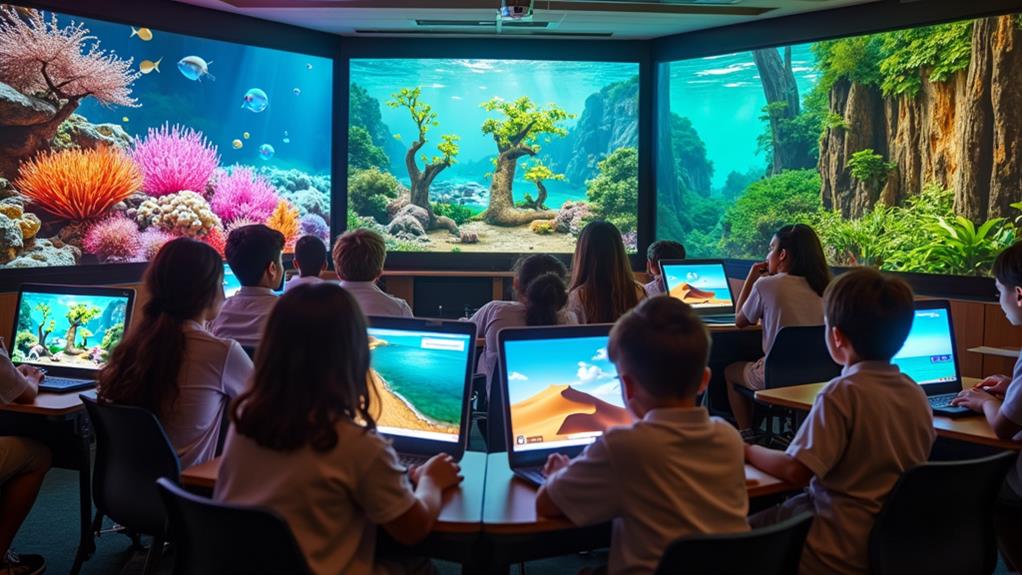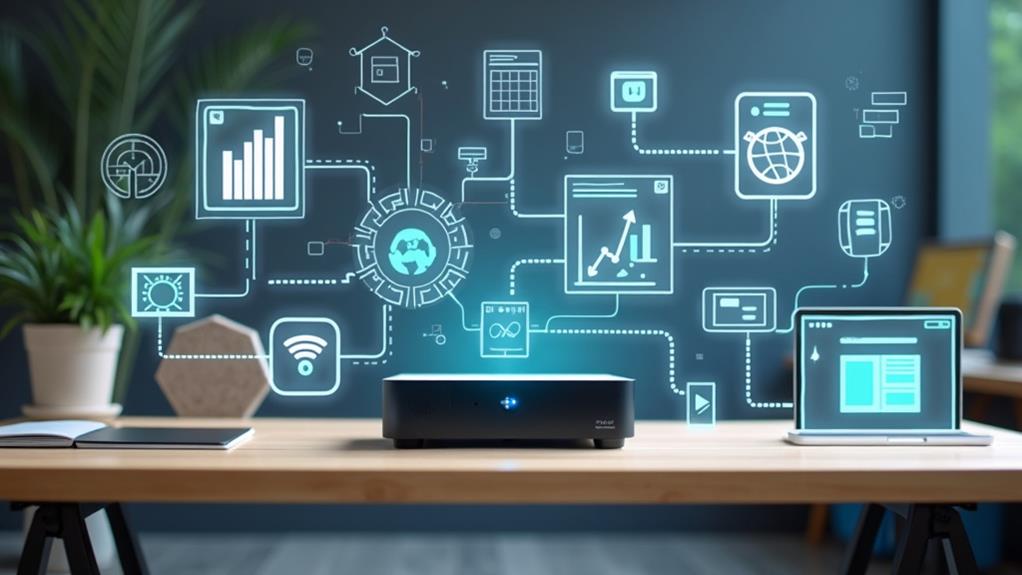



Imagine a world where your desktop computer fits in the palm of your hand. A mini PC, as its name suggests, is a compact and portable alternative to the traditional personal computer. But is it really as normal and functional as its larger counterpart? In this article, we will explore the features and capabilities of mini PCs, and unravel whether they can truly meet your everyday computing needs. Whether you’re a tech enthusiast or just curious about the latest innovations, join us as we take a closer look at the world of mini PCs.
Advantages of Mini PC
Compact Size
One of the biggest advantages of a mini PC is its compact size. These miniature computers are significantly smaller than traditional desktop PCs, making them ideal for those with limited space. Whether you’re living in a small apartment or need a computer for your dorm room, a mini PC can fit seamlessly into any tight space. The compact size also makes it easier to transport, allowing you to take your computer with you wherever you go.
Portability
In addition to their compact size, mini PCs are highly portable. Gone are the days when you had to lug around a bulky desktop computer or rely on a heavy laptop. Mini PCs are lightweight and can easily fit into a backpack or carry-on luggage. This portability is especially advantageous for students and frequent travelers who need a reliable computer on the go. With a mini PC, you can work or stream your favorite movies and shows from anywhere, without being weighed down by a heavy device.
Energy Efficiency
Mini PCs are known for their energy efficiency. Unlike traditional desktop computers that consume a significant amount of power, mini PCs are designed to be more energy-efficient, helping you save on electricity costs. These compact computers are equipped with low-power processors and require less cooling, resulting in lower energy consumption. Additionally, many mini PCs are built with energy-saving features such as automatic power-off and sleep modes, further reducing their ecological footprint.
Disadvantages of Mini PC
Limited Processing Power
While mini PCs offer many advantages, they do come with a few limitations. One of the main drawbacks is their limited processing power compared to traditional desktop computers. Mini PCs are generally equipped with low-power processors, which may not be able to handle resource-intensive tasks such as video editing or gaming. If you rely on heavy-duty software or applications, a mini PC may not be the best choice for you. However, for everyday tasks like web browsing, document editing, and media streaming, a mini PC can still provide satisfactory performance.
Reduced Storage Capacity
Another disadvantage of mini PCs is their reduced storage capacity. Due to their compact size, mini PCs are typically equipped with smaller storage options such as solid-state drives (SSDs) or embedded flash memory. This limited storage space may not be sufficient for storing large amounts of files, videos, or games. However, with the availability of external storage options such as portable hard drives and cloud storage solutions, this drawback can be mitigated to an extent. It’s important to consider your storage needs before purchasing a mini PC and explore ways to expand the storage capacity if necessary.

Mini PC Applications
Home Entertainment
Mini PCs are excellent choices for home entertainment setups. Their small form factor blends seamlessly into your living room or entertainment area, eliminating the need for bulky and unsightly desktop towers. Mini PCs can be connected to your TV or monitor, turning them into multimedia centers for streaming movies, TV shows, and music. With the right hardware and software, you can enjoy a full-fledged home theater experience, complete with high-quality audio and video playback.
Digital Signage
The compact size and portability of mini PCs make them ideal for digital signage applications. Whether you’re running a small business or organizing an event, mini PCs can power displays and touchscreens to deliver engaging content to your audience. Mini PCs can be easily mounted behind screens or integrated into kiosks, offering a sleek and professional look. Their low power consumption and reliability make them cost-effective solutions for digital signage, allowing you to display advertisements, menus, and interactive information without breaking the bank.
Industrial Use
Mini PCs find significant applications in various industrial settings. Their compact size and energy efficiency make them suitable for environments where space and power consumption are crucial considerations. Mini PCs can be integrated into manufacturing equipment, surveillance systems, and Internet of Things (IoT) devices, providing reliable computing power for data collection, analysis, and control. Additionally, their durability and resistance to harsh conditions make them suitable for industries such as manufacturing, logistics, and automation.
Comparison with Traditional PC
Processing Power
When comparing mini PCs to traditional desktop computers, one area where mini PCs often fall short is processing power. Traditional desktop computers are usually equipped with more powerful processors, capable of handling demanding tasks and resource-intensive applications. Mini PCs typically feature low-power CPUs, which may not deliver the same level of performance as their larger counterparts. If you require heavy-duty processing capabilities for tasks like video editing, 3D modeling, or gaming, a traditional PC may be the better choice. However, for everyday computing needs, such as web browsing, document editing, and multimedia consumption, a mini PC can still provide satisfactory performance.
Storage Capacity
Another aspect in which mini PCs differ from traditional PCs is storage capacity. Traditional desktop computers typically offer a greater range of storage options, including larger hard disk drives (HDDs) or high-capacity solid-state drives (SSDs). In contrast, mini PCs often come with smaller storage capacities, such as embedded flash memory or smaller SSDs. This limited storage space may pose a challenge if you need to store a large amount of data, media files, or high-resolution videos. However, with the availability of external storage solutions and cloud storage, you can easily expand the storage capacity of a mini PC to meet your needs.
Expandability
One of the advantages traditional desktop computers have over mini PCs is their expandability. Traditional PCs typically offer more slots and ports for adding additional components such as graphics cards, sound cards, or expansion cards. This allows users to upgrade their computers with more powerful hardware as their needs evolve over time. In contrast, mini PCs often have limited expansion options due to their compact size. While some mini PCs offer limited upgrade possibilities such as additional RAM or storage, they may not have the same level of expandability as traditional PCs. If expandability is a crucial factor for you, it’s important to consider this aspect before choosing a mini PC.

Mini PC Operating Systems
Windows
Windows is one of the most popular operating systems for mini PCs. The familiarity and wide range of software compatibility make it a preferred choice for many users. Windows offers a user-friendly interface with extensive customization options, allowing you to personalize your mini PC to suit your preferences. It supports a vast software library, enabling you to run a wide range of applications for productivity, entertainment, and gaming. Additionally, Windows provides regular updates and security patches, ensuring that your mini PC stays up to date and protected.
Linux
Linux is an open-source operating system that offers a high level of customization and flexibility. It is known for its stability, security, and performance, making it an excellent choice for mini PCs. Linux distributions such as Ubuntu, Fedora, and Debian are specifically designed to be lightweight, allowing them to run smoothly on low-power hardware. Linux provides a vast selection of free and open-source software, making it a cost-effective option for those who want to avoid software licensing fees. However, Linux may have a steeper learning curve for users who are not familiar with its command-line interface and software installation processes.
Android
Android, primarily known as a mobile operating system, has gained popularity as an operating system for mini PCs. Its touch-friendly interface and extensive app ecosystem make it suitable for multimedia consumption and casual computing. Android offers a range of productivity apps, media players, and games, allowing you to transform your mini PC into a versatile entertainment device. While Android may not provide the same level of compatibility and software options as Windows or Linux, it offers a lightweight and intuitive user experience that is particularly appealing to users who are comfortable with mobile devices.
Factors to Consider Before Buying a Mini PC
Processor
One of the key factors to consider before purchasing a mini PC is the processor. The processor determines the overall performance and speed of the computer. Mini PCs typically come with low-power processors, which are suitable for basic tasks such as web browsing, document editing, and media streaming. However, if you require more processing power for tasks like video editing or gaming, you may need to opt for a mini PC with a more powerful processor. It’s important to consider your computing needs and choose a processor that can handle the software and applications you plan to use.
RAM
Another important consideration is the amount of RAM (random access memory) in the mini PC. RAM plays a vital role in the computer’s performance, as it stores data that the processor needs to access quickly. Mini PCs generally come with varying amounts of RAM, ranging from 2GB to 16GB or more. If you plan to multitask or use memory-intensive applications, it’s recommended to choose a mini PC with a higher amount of RAM. This will ensure smoother performance and faster response times, allowing you to work efficiently without experiencing lag or slowdowns.
Storage
The storage capacity of a mini PC is another crucial factor to consider. Mini PCs typically come with smaller storage options, such as solid-state drives (SSDs) or embedded flash memory. While SSDs offer faster boot times and data transfer speeds, they often come with smaller storage capacities compared to traditional hard disk drives (HDDs). It’s important to assess your storage needs and choose a mini PC with sufficient storage capacity for your files, applications, and media. Additionally, consider if the mini PC offers expandable storage options or if you can utilize external storage solutions to meet your requirements.
Connectivity Options
Before buying a mini PC, it’s essential to consider the available connectivity options. Mini PCs generally have fewer ports compared to traditional desktop computers, due to their smaller size. However, it’s important to ensure that the mini PC has the necessary ports and connectivity options that you need for your specific requirements. Consider factors such as the number of USB ports, HDMI or DisplayPort outputs, Ethernet ports, and wireless connectivity options such as Wi-Fi and Bluetooth. If you plan to connect peripherals, external displays, or other devices to your mini PC, make sure it has the necessary connectivity options to support your setup.
How to Set Up a Mini PC
Choosing a Location
When setting up a mini PC, it’s important to choose the right location. Consider factors such as ventilation, accessibility, and ergonomics. Mini PCs generate heat, so it’s important to place them in a well-ventilated area to prevent overheating. Ensure that there is sufficient airflow around the mini PC to dissipate heat effectively. Additionally, choose a location that is easily accessible for connecting and disconnecting peripherals, such as USB devices or HDMI cables. Lastly, consider ergonomics and choose a location that allows for comfortable use, whether it’s at a desk, on a shelf, or mounted behind a monitor.
Connecting Peripherals
Once you have chosen the location for your mini PC, it’s time to connect the necessary peripherals. Start by connecting the power cable to the mini PC and plugging it into a power outlet. Next, connect your keyboard and mouse to the available USB ports or wireless receivers. If you plan to connect external speakers or headphones, locate the audio output port and connect the appropriate cables. Finally, if you’re connecting a monitor or TV, locate the HDMI or DisplayPort output on the mini PC and connect it to the corresponding input on your display device.
Installing Software
To complete the setup of your mini PC, you’ll need to install the necessary software. Most mini PCs come with pre-installed operating systems such as Windows, Linux, or Android. If the mini PC doesn’t come with an operating system, you’ll need to install one yourself. Follow the manufacturer’s instructions for installing the operating system, which usually involves creating a bootable USB drive or DVD and following the on-screen prompts. Once the operating system is installed, you can start installing additional software or applications according to your needs. Ensure that your mini PC has the necessary drivers and software updates to ensure optimal performance and compatibility.
Tips for Maximizing Performance on a Mini PC
Optimizing Storage
To maximize the performance of your mini PC, it’s important to optimize your storage. Start by regularly cleaning up unnecessary files, such as temporary files, browser caches, and old downloads. This will free up valuable storage space and help improve overall system performance. Additionally, consider moving large files or media libraries to external storage solutions or cloud storage to conserve space on the mini PC’s internal storage. Regularly defragmenting or optimizing the storage drive can also help improve read and write speeds, enhancing overall performance.
Managing Background Processes
To ensure smooth and efficient performance on your mini PC, it’s important to manage background processes. Some applications or services may run in the background and consume valuable system resources, leading to slowdowns or lag. Take a look at the list of startup programs and disable unnecessary ones to reduce the load on your mini PC’s processor and memory. Additionally, regularly monitor and close any unnecessary applications or processes running in the background to free up system resources for the tasks at hand. By managing background processes effectively, you can ensure that your mini PC runs smoothly and efficiently.
Upgrading Hardware
While mini PCs have their limitations in terms of hardware upgradeability, there are still some components that can be upgraded to enhance performance. For example, if your mini PC allows for RAM upgrades, consider adding more RAM to improve multitasking capabilities and overall system performance. Additionally, if the mini PC has a replaceable storage drive, consider upgrading to a larger capacity SSD for faster boot times and storage versatility. However, it’s important to check the specifications and compatibility of the mini PC before attempting any hardware upgrades. Some mini PCs may have soldered or fixed components, which cannot be easily upgraded.
Future Trends in Mini PC Technology
Increased Processing Power
As technology continues to advance, mini PCs are likely to see improvements in processing power. Manufacturers are constantly pushing the boundaries of low-power processors, developing chips that offer higher performance while maintaining energy efficiency. This means that future mini PCs may be capable of handling more demanding tasks such as video editing, gaming, and virtual reality applications. Increased processing power will make mini PCs even more versatile and allow users to enjoy a wider range of software and applications on these compact devices.
Enhanced Connectivity
With the increasing prevalence of smart home devices and IoT devices, enhanced connectivity will be a key trend in mini PC technology. Future mini PCs are likely to offer a wider range of connectivity options, allowing users to seamlessly connect and control various devices in their homes or workplaces. This may include built-in support for wireless protocols such as Zigbee or Z-Wave, allowing mini PCs to act as central hubs for smart home automation. Additionally, improvements in wireless technologies such as Wi-Fi 6 and Bluetooth 5 will provide faster and more stable connections, enhancing the overall user experience.
Improved Cooling Systems
Heat management is a critical aspect of mini PC design, and future trends will focus on improving cooling systems. As mini PCs become more powerful, they generate more heat, requiring effective cooling solutions to prevent thermal throttling and ensure optimal performance. Manufacturers may introduce innovative cooling technologies such as advanced heatsinks, vapor chamber cooling, or liquid cooling systems to dissipate heat more efficiently. These advancements will not only enhance the performance and longevity of mini PCs but also allow for quieter operation, as cooling systems become more sophisticated and optimized.
Conclusion
Mini PCs offer various advantages and applications that make them a compelling choice for users in different scenarios. Their compact size, portability, and energy efficiency are especially beneficial for those with limited space or a need for on-the-go computing. While mini PCs may have limitations in processing power and storage capacity compared to traditional desktop computers, they can still meet the needs of everyday tasks and specific applications such as home entertainment, digital signage, and industrial use.
When considering a mini PC, factors such as the processor, RAM, storage, and connectivity options should be carefully evaluated to ensure that the device meets your specific requirements. Setting up a mini PC involves choosing the right location, connecting peripherals, and installing the necessary software. Maximizing performance on a mini PC can be achieved by optimizing storage, managing background processes, and considering hardware upgrades if available.
As technology advances, future trends in mini PC technology include increased processing power, enhanced connectivity, and improved cooling systems. These developments will further expand the capabilities and applications of mini PCs, making them even more versatile and appealing to a wider range of users.
In conclusion, mini PCs offer a compact and efficient computing solution for various needs, and with the right considerations and optimizations, they can provide a reliable and enjoyable computing experience. Whether for home use, business applications, or industrial environments, mini PCs have proven their worth and are likely to continue evolving and improving in the future.
Disclosure: As an Amazon Associate, I earn from qualifying purchases.







